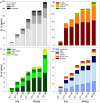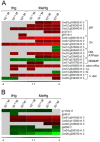Cellular toxicity pathways of inorganic and methyl mercury in the green microalga Chlamydomonas reinhardtii
- PMID: 28808314
- PMCID: PMC5556115
- DOI: 10.1038/s41598-017-08515-8
Cellular toxicity pathways of inorganic and methyl mercury in the green microalga Chlamydomonas reinhardtii
Abstract
Contamination by mercury (Hg) is a worldwide concern because of Hg toxicity and biomagnification in aquatic food webs. Nevertheless, bioavailability and cellular toxicity pathways of inorganic (IHg) and methyl-Hg (MeHg) remain poorly understood. We analyzed the uptake, transcriptomic, and physiological responses in the microalga Chlamydomonas reinhardtii exposed to IHg or MeHg. Bioavailability of MeHg was up to 27× higher than for IHg. Genes involved in cell processes, energy metabolism and transport were dysregulated by both Hg species. Physiological analysis revealed an impact on photosynthesis and reduction-oxidation reaction metabolism. Nevertheless, MeHg dysregulated a larger number of genes and with a stronger fold-change than IHg at equivalent intracellular concentration. Analysis of the perturbations of the cell's functions helped to derive a detailed mechanistic understanding of differences in cellular handling of IHg and MeHg resulting in MeHg having a stronger impact. This knowledge is central for the prediction of impact of toxicants on organisms.
Conflict of interest statement
The authors declare that they have no competing interests.
Figures




References
Publication types
MeSH terms
Substances
LinkOut - more resources
Full Text Sources
Other Literature Sources
Molecular Biology Databases

